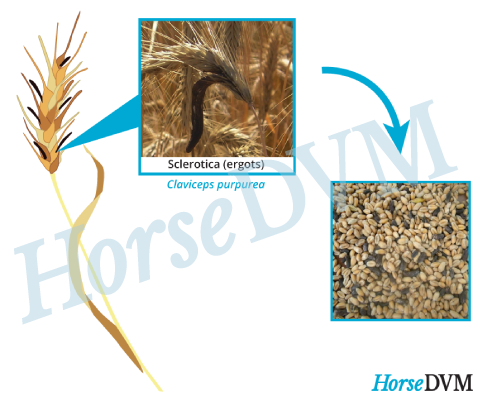Ergotism is caused by the consumption of feed, crops, and pasture grasses contaminated with ergot sclerotia of
Claviceps species.
Claviceps are a type of fungi which produces ergot alkaloids. The type and amount of alkaloids present depend on the species of
Claviceps, host plant, and environmental factors.
Claviceps are found within ergots, which are hard purplish bodies (sclerotia) which replace sporadic grain kernels within the flowering portions of common crops (wheat, rye, triticale, barley, oats, cultivated and wild oats).
Sometimes ergots can be visible to the naked eye, as they are able to grow to almost 10 times the size of the average grain kernel, however they can also be very small and be undetectable to the naked eye. Ergot alkaloids are also produced by endophyte-contaminated grasses (tall fescue, ryegrass, sleepy grass, drunken horse grass,
Paspalum grasses, bermuda grass, tobosa grass (
Hilaria mutica), galleta grass (
H. jamesii) and fine fescues).
Forms of Ergotism
Ergotism can present as either a gangrenous form or a convulsive form.
- Gangrenous form: Lameness and gangrene are the major signs of the gangrenous form of ergotism. Vasoconstriction of the arterials combined with vascular thrombosis, stasis of blood flow and damage to capilliary endothelium results in diminished blood supply to the comb and feet. Reduced blood flow leads to necrosis and subsequently gangrene. Cold weather will increase the severity of the signs.
- Convulsive form: Initially chickens will present with mild trembling and ataxia. These signs will usually worsen or present when the bird is disturbed or hears a sudden noise.
